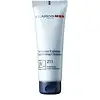What's inside
What's inside
 Key Ingredients
Key Ingredients

 Benefits
Benefits

 Concerns
Concerns

 Ingredients Side-by-side
Ingredients Side-by-side

Water
Skin ConditioningGlycerin
HumectantStearic Acid
CleansingMyristic Acid
CleansingPotassium Hydroxide
BufferingDimethicone
EmollientLauric Acid
CleansingSodium Lauroyl Sarcosinate
CleansingBambusa Arundinacea Stem Extract
Skin ConditioningTipa-Laureth Sulfate
CleansingGlycol Distearate
EmollientGlyceryl Behenate
EmollientParfum
MaskingPropanediol
SolventParaffin
PerfumingPumice
AbrasiveCI 77891
Cosmetic ColorantMannitol
HumectantSynthetic Wax
AbrasivePropylene Glycol
HumectantSodium Chloride
MaskingSodium Laurate
CleansingCellulose
AbsorbentTetrasodium EDTA
Hydrogenated Microcrystalline Wax
Emulsion StabilisingHierochloe Odorata Extract
MaskingZinc Gluconate
Skin ConditioningSaponaria Officinalis Root Extract
Skin ConditioningCI 77007
Cosmetic ColorantSodium Salicylate
PreservativePhenoxyethanol
PreservativeAcrylates/Ammonium Methacrylate Copolymer
Triethyl Citrate
MaskingHydroxypropyl Methylcellulose
Emulsion StabilisingPotassium Sorbate
PreservativeWater, Glycerin, Stearic Acid, Myristic Acid, Potassium Hydroxide, Dimethicone, Lauric Acid, Sodium Lauroyl Sarcosinate, Bambusa Arundinacea Stem Extract, Tipa-Laureth Sulfate, Glycol Distearate, Glyceryl Behenate, Parfum, Propanediol, Paraffin, Pumice, CI 77891, Mannitol, Synthetic Wax, Propylene Glycol, Sodium Chloride, Sodium Laurate, Cellulose, Tetrasodium EDTA, Hydrogenated Microcrystalline Wax, Hierochloe Odorata Extract, Zinc Gluconate, Saponaria Officinalis Root Extract, CI 77007, Sodium Salicylate, Phenoxyethanol, Acrylates/Ammonium Methacrylate Copolymer, Triethyl Citrate, Hydroxypropyl Methylcellulose, Potassium Sorbate
Water
Skin ConditioningCocamidopropyl Hydroxysultaine
CleansingCoco-Betaine
CleansingSodium Lauroyl Oat Amino Acids
CleansingDecyl Glucoside
CleansingSodium Cocoyl Sarcosinate
CleansingAcrylates Copolymer
Sodium Chloride
MaskingDisodium Cocoyl Glutamate
CleansingGlycerin
HumectantCaffeine
Skin ConditioningSodium Cocoyl Glutamate
CleansingMonosodium Citrate
BufferingButylene Glycol
HumectantCitric Acid
BufferingCharcoal Powder
AbrasiveSodium Hydroxide
BufferingDisodium EDTA
Methylchloroisothiazolinone
PreservativeMethylisothiazolinone
PreservativePhenoxyethanol
PreservativeCI 77499
Cosmetic ColorantWater, Cocamidopropyl Hydroxysultaine, Coco-Betaine, Sodium Lauroyl Oat Amino Acids, Decyl Glucoside, Sodium Cocoyl Sarcosinate, Acrylates Copolymer, Sodium Chloride, Disodium Cocoyl Glutamate, Glycerin, Caffeine, Sodium Cocoyl Glutamate, Monosodium Citrate, Butylene Glycol, Citric Acid, Charcoal Powder, Sodium Hydroxide, Disodium EDTA, Methylchloroisothiazolinone, Methylisothiazolinone, Phenoxyethanol, CI 77499
Ingredients Explained
These ingredients are found in both products.
Ingredients higher up in an ingredient list are typically present in a larger amount.
Glycerin is already naturally found in your skin. It helps moisturize and protect your skin.
A study from 2016 found glycerin to be more effective as a humectant than AHAs and hyaluronic acid.
As a humectant, it helps the skin stay hydrated by pulling moisture to your skin. The low molecular weight of glycerin allows it to pull moisture into the deeper layers of your skin.
Hydrated skin improves your skin barrier; Your skin barrier helps protect against irritants and bacteria.
Glycerin has also been found to have antimicrobial and antiviral properties. Due to these properties, glycerin is often used in wound and burn treatments.
In cosmetics, glycerin is usually derived from plants such as soybean or palm. However, it can also be sourced from animals, such as tallow or animal fat.
This ingredient is organic, colorless, odorless, and non-toxic.
Glycerin is the name for this ingredient in American English. British English uses Glycerol/Glycerine.
Learn more about GlycerinPhenoxyethanol is a preservative that has germicide, antimicrobial, and aromatic properties. Studies show that phenoxyethanol can prevent microbial growth. By itself, it has a scent that is similar to that of a rose.
It's often used in formulations along with Caprylyl Glycol to preserve the shelf life of products.
Chances are, you eat sodium chloride every day. Sodium Chloride is also known as table salt.
This ingredient has many purposes in skincare: thickener, emulsifier, and exfoliator.
You'll most likely find this ingredient in cleansers where it is used to create a gel-like texture. As an emulsifier, it also prevents ingredients from separating.
There is much debate on whether this ingredient is comedogenic. The short answer - comedogenic ratings don't tell the whole story. Learn more about comegodenic ratings here.
The concensus about this ingredient causing acne seems to be divided. Research is needed to understand if this ingredient does cause acne.
Scrubs may use salt as the primary exfoliating ingredient.
Learn more about Sodium ChlorideWater. It's the most common cosmetic ingredient of all. You'll usually see it at the top of ingredient lists, meaning that it makes up the largest part of the product.
So why is it so popular? Water most often acts as a solvent - this means that it helps dissolve other ingredients into the formulation.
You'll also recognize water as that liquid we all need to stay alive. If you see this, drink a glass of water. Stay hydrated!
Learn more about Water